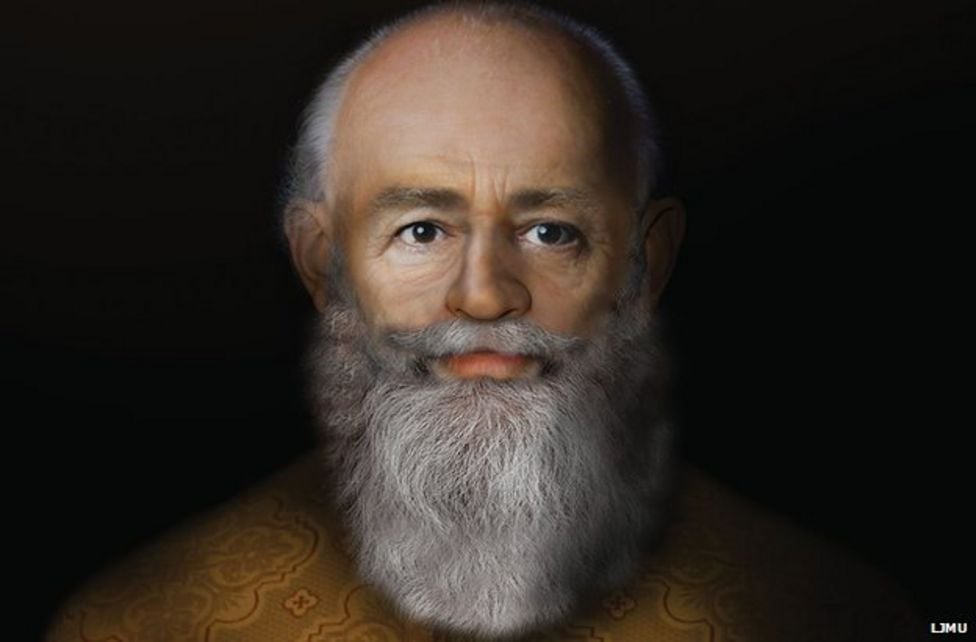
Despite the many myths surrounding some Christmas characters, certain legendary figures are actually rooted in history, and Saint Nicholas, otherwise known as Santa Claus, is one of them. Recently, scientists at Liverpool John Moores University used his skull to reconstruct his face.
Elected as Bishop of Myra, in Asia Minor, in the fourth century AD — before Christianity was even legalized in the Roman Empire — his life was full of difficulty and controversy, but he has gone down as one of the most beloved men in human history.
After his election to the office, he was imprisoned during the great persecution of Christians that took place during the reign of Emperor Diocletian; he was later released when Constantine came to power.
He may — or may not — have thrown three gold coins down a man’s chimney in order to help him avoid having to sell his daughters into slavery as a result of his poverty.
He may — or may not — have punched a man in the face over the Arian controversy which was dividing Christianity at that time, separating believers into camps of those who thought Christ was divine and those that did not.
But no one can doubt that Saint Nicholas was a Christian bishop from Myra, and he took part in the Council at Nicea in the year 325, where the Creed that Christians believe in was first formulated.

Born in 270 in the then-Greek town of Patara, Nicholas traveled to Palestine and Egypt before returning to become bishop of Myra.
After his death, his burial site near his church in Myra quickly became a shrine that was frequented by the faithful. Sailors from Bari, Italy, stole most of his remains in the year 1087, taking them back to their city, where they remain enshrined even today.
The skull that was used in the recreation was taken from his tomb in Bari.

The bones of Saint Nicholas have been the focus of repeated looting and disturbance over the centuries, but no one disputes the fact that the largest bones of his skeleton were taken by subterfuge to Bari, Italy, in the early 1000’s, where they have stayed ever since that time.
Scientists recreate the face of Saint Nicholas aka Santa Claus
Recently, scientists at Liverpool John Moores University took his skull and recreated his face from it, using modern technology to make a visage that is startling in its realism — and one that has a broken nose — perhaps giving a bit of credence to the fistfight with the priest and ascetic Arius that may or may not have broken out at the Council.
As they note, the skull shows signs of a broken nose that has re-set itself, as they do, off to one side of the face. Although icon writers did not mimic his apparently broken nose, the recreated face otherwise shows striking similarities to the many icons of the saint that have been created over the years.
Scientists at the university in Liverpool then unveiled what they say is the most realistic portrait ever created of St. Nicholas of Myra, the popular 4th century bishop best known as the inspiration for the modern-day figure of Santa Claus.
Researchers at the University’s Face Lab used a facial reconstruction system and 3D interactive technology to create the portrait, which was unveiled on Dec. 6, 2014 – the feast day of St. Nicholas.
University Professor Caroline Wilkinson told the BBC that the reconstruction relied on “all the skeletal and historical material” available, while a university spokeswoman said the new image is a product of “the most up-to-date anatomical standards, Turkish tissue depth data and CGI techniques.”
The saint, who died in the year 343, has gone on to become revered for his generosity, eventually transforming into the jolly man with the red hat who loved to give presents to others.
He was said to have left gifts in secret, such as putting coins in shoes that had been left out for him, eventually leading him to become known forever after as “Santa Claus,” with “Claus” the German version of the name “Nicholas.”
The recreation clearly shows Saint Nicholas’ severely broken nose, which Wilkinson said had “healed asymmetrically, giving him a characteristic nose and rugged facial appearance.” Professor Wilkinson added that it was “thrilling to be able to show the face of this famous bishop.”
See all the latest news from Greece and the world at Greekreporter.com. Contact our newsroom to report an update or send your story, photos and videos. Follow GR on Google News and subscribe here to our daily email!



